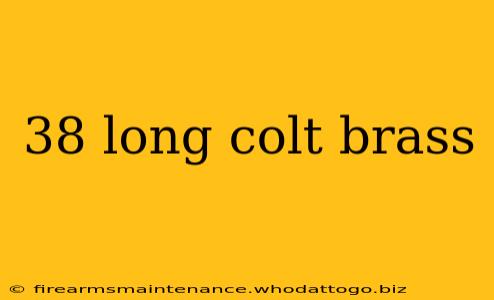The .38 Long Colt cartridge, while perhaps overshadowed by its more modern counterparts, holds a significant place in firearms history. This article delves into the fascinating history of the .38 Long Colt brass, explores its technical specifications, and examines its continued relevance in today's shooting world.
A Legacy Forged in the Wild West
The .38 Long Colt, first introduced in 1878, wasn't just another cartridge; it was a pivotal piece of American history. Developed by Colt's Patent Firearms Manufacturing Company for their Single Action Army revolver, the .38 Long Colt quickly became synonymous with the Wild West. Images of cowboys and lawmen wielding these revolvers are deeply ingrained in our collective imagination, inextricably linking the cartridge to a romanticized era of American history. Its relatively powerful round for its time provided a reliable stopping power, making it a favored choice for both self-defense and hunting small game.
Key Specifications of .38 Long Colt Brass:
- Caliber: .38 inch (9.65 mm)
- Case Type: Straight-walled, cylindrical
- Common Bullet Weights: 125-158 grains (8-10 grams)
- Uses: Revolvers (primarily), some early rifles and carbines.
The Evolution of .38 Long Colt Brass: From Black Powder to Modern Loads
Initially loaded with black powder, the .38 Long Colt's performance was significantly improved with the advent of smokeless powder. This transition allowed for increased accuracy, velocity, and reduced fouling. Modern .38 Long Colt ammunition utilizes a variety of bullet designs, ranging from round-nose to hollow-point, offering shooters a selection tailored to their specific needs, whether target shooting, plinking, or hunting.
Understanding the Variations in .38 Long Colt Brass Cases
While the basic design remains consistent, variations exist in .38 Long Colt brass casings. These differences often relate to headstamp markings, indicating manufacturer and sometimes even production date. Collectors often pay close attention to these subtle differences, adding another layer of interest to the cartridge. Furthermore, the availability of different brass manufacturers means choices exist based on quality, price point, and specific desired properties.
The .38 Long Colt Brass Today: A Continued Presence
Despite its age, the .38 Long Colt remains a popular cartridge. Its relatively low recoil makes it suitable for novice shooters, while its historical significance continues to attract collectors and enthusiasts. The cartridge's adaptability, capable of firing both lead and jacketed bullets, adds to its versatility. Many modern manufacturers continue to produce .38 Long Colt ammunition, ensuring its continued availability for years to come. Additionally, the relatively low cost of ammunition compared to some more modern cartridges makes it an attractive choice for recreational shooting.
Beyond Shooting: The Collector's Market
The historical significance of .38 Long Colt brass makes it a highly sought-after item for collectors. Finding original, historically significant brass casings can be a rewarding endeavor for those passionate about firearms history. The condition of the brass, its headstamps, and any unique markings all contribute to its value in the collector's market.
Conclusion: A Timeless Cartridge
The .38 Long Colt brass isn't just a piece of metal; it represents a significant chapter in American history and firearms technology. From its Wild West origins to its continued presence in shooting ranges and collections today, this cartridge continues to captivate and intrigue. Its history, specifications, and ongoing relevance make the .38 Long Colt a fascinating subject for both seasoned shooters and those newly exploring the world of firearms.

